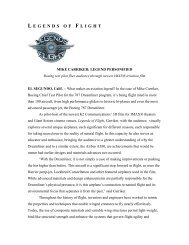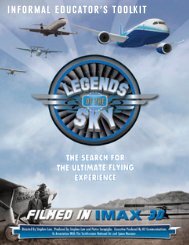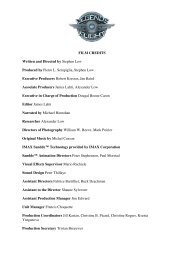download - Legends of Flight
download - Legends of Flight
download - Legends of Flight
Create successful ePaper yourself
Turn your PDF publications into a flip-book with our unique Google optimized e-Paper software.
60 SECOND SCIENCE ACTIVITY<br />
FOR MUSEUM DOCENTS<br />
Forces <strong>of</strong> <strong>Flight</strong>:<br />
Propeller & Parachute Toys<br />
(1 minute)<br />
Four forces are required for flight: gravity, lift, drag, and<br />
thrust. With two simple toys and sixty seconds, you can quickly<br />
demonstrate the forces <strong>of</strong> flight. Lift, thrust, and gravity can be<br />
demonstrated with a propeller toy. Drag and gravity can be<br />
demonstrated with a parachute toy.<br />
Key Information:<br />
Ages: Appropriate for ages five and older.<br />
Key Concept: Four forces <strong>of</strong> flight: gravity, lift, thrust, and drag.<br />
Objectives: Museum visitors will be able to understand that<br />
gravity, lift, thrust, and drag are the four forces that are<br />
needed for flight.<br />
Education Standards:<br />
National Science Education Standards for Grades K-4<br />
Position and Motion <strong>of</strong> Objects: Students develop abilities<br />
to describe the position and motion <strong>of</strong> objects.<br />
National Science Education Standards for Grades 5-8<br />
Motions and Forces: Students develop abilities to describe<br />
the position, direction, motion, and speed <strong>of</strong> objects.<br />
National Science Education Standards for Grades 9-12<br />
Motions and Forces: Students develop abilities to<br />
describe and measure the position, direction, motion,<br />
and speed <strong>of</strong> objects.<br />
Summary <strong>of</strong> Supplies:<br />
Item<br />
Aero-Prop<br />
toy propeller<br />
Paratrooper<br />
parachute toy<br />
Safety Guidelines:<br />
Description<br />
Plastic toy propellers with a propeller blade<br />
that is 3” (7.62 x 1.91 cm). The propellers<br />
can be imprinted with a custom message.<br />
Available from Aero-Motion<br />
(www.aero-motion.com) or other online toy<br />
stores. Cost: about $.80 each.<br />
3” (7.62 cm) tall plastic figure with a plastic<br />
parachute attached with string. Available<br />
from toy stores or party stores. Cost: about<br />
$.20 each.<br />
Quantity<br />
The Aero-Prop toys can fly up to 35’ (10.67 m) in the air. Carefully<br />
choose a location for this program so that other museum visitors<br />
will not be at risk <strong>of</strong> getting struck by a flying Aero-Prop toy.<br />
5<br />
5<br />
Procedure:<br />
1. Welcome the museum visitor. Ask the visitor if he/she would<br />
like to investigate the four forces <strong>of</strong> flight with some fun flying<br />
toys.<br />
2. Explain that there are four forces that together allow for flight<br />
to occur. These are gravity, lift, drag, and thrust.<br />
ACTIVITY 1: LIFT AND THRUST<br />
3. Aviation engineers have many challenges when they design an<br />
airplane. The first challenge is to design an airplane that has<br />
enough upward lift to counteract the downward pull <strong>of</strong> gravity.<br />
4. Hand the visitor an Aero-Prop toy and show them how to<br />
launch the propeller into the air.<br />
• Hold the stick <strong>of</strong> the toy between the inside <strong>of</strong> your left<br />
palm and the fingertips <strong>of</strong> your right hand.<br />
• Tilt the propeller forward, away from your body.<br />
• Launch the toy by squeezing the stick between your two<br />
hands and rolling your right hand forward in a quick and<br />
firm motion.<br />
5. Ask:<br />
• What force do you think is pulling down on the toy? (Gravity).<br />
• What force do you think is allowing the toy to counteract gravity<br />
and fly up into the air? (Lift is lifting the toy up against the pull <strong>of</strong><br />
gravity).<br />
• What provides lift? (The airfoil shape <strong>of</strong> the propeller).<br />
• What provides thrust? (The spinning motion <strong>of</strong> the propeller).<br />
6. Have the visitor launch their Aero-Prop again and together,<br />
watch the path that the toy makes. Ask the visitor:<br />
• Would you want to ride on an airplane that only moved upward?<br />
(No, you want to go somewhere).<br />
• What helps the airplane move forward? (The spinning motion <strong>of</strong><br />
the propeller; this is thrust)<br />
ACTIVITY 2: DRAG<br />
7. Introduce the concept <strong>of</strong> drag by asking the visitor:<br />
• What would happen if we put a 20-foot tall windshield on the front<br />
<strong>of</strong> a plane? Would it fly well? Would it speed up or slow down?<br />
8. Hand the visitor a parachute toy and show them how to hold<br />
the toy with the parachute closed, and then throw the toy into<br />
the air so that the parachute opens and the toy slowly floats<br />
back down to you.<br />
9. Ask:<br />
• We have talked about gravity pulling down, lift lifting upwards,<br />
and thrust pushing forward. What force do you think<br />
is slowing the toy so that it doesn’t just plummet down to the<br />
ground? (Drag is caused by the shape <strong>of</strong> the parachute).<br />
Notes to Presenter:<br />
This 60 Second Science Activity is appropriate for all ages. Given<br />
the short presentation time, the activity focuses on only one main<br />
concept, making it appropriate for younger children. Here are<br />
some ways to adapt the activity for different age groups:<br />
3





